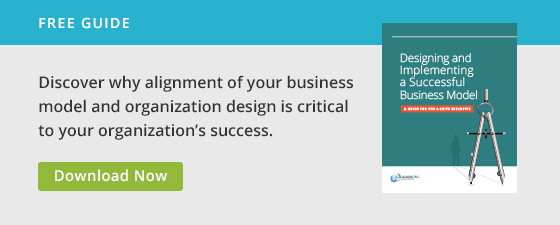Often, organizations look to outside partners to assist with organization transformation. This is natural, as organization design and change demand specific skill sets that are not always readily available within an organization or easily hired. However, the opportunity also exists for organizations to build these capabilities internally.
There are many things to consider in advance if this is to be attempted. Leaders must establish a toolset, decide which skills should be developed and by whom, and determine exactly what the people who gain these capabilities will be responsible to do, among other things. However, we have found that the best indicators of success have to do with two specific variables. First, individuals in training should have access to experienced organization design mentorship. Second, organization leaders must have a level of understanding of transformation principles and practices.
The Critical Role of Mentorship in Organization Transformation
Individuals can effectively learn many disciplines by studying theory. An intelligent person with related skills can pick up basic competence from a book or videos or a college course. They can expect to achieve a basic level of success when they put their hand to it. Organization design is not one of these disciplines. It requires more than a review of theory and principles, it requires a certain degree of hands-on experience.
I have many times observed people who have received competent, in-depth training in organization design turn around and try to use what they learned, only to end up doing it in ways that are significantly wrong. When asked, some of them are unable to explain the theory they learned. That’s a clear disconnect. But many times the trained individual can play it back perfectly, and you wonder what went wrong. I don’t think this is a reflection of their intelligence. Most professionals are capable of learning organizational design and related organization transformation skills. Still, the number of people who don’t apply principles and tools effectively is surprising.
To illustrate this, let’s look at the allocation of time. Even with training, someone who has not done organization transformation work will have a limited view of how much time to allocate to needed conversations. Sometimes they grant too much time to a conversation that is very straightforward. Other times they allocate almost no time to a discussion that is likely to be time consuming and highly contentious. Another common example is when they forget or misrepresent how a framework is supposed to work. This confuses the people who are supposed to use the framework to clarify their thinking and come up with solutions using it.
This lack of understanding in how to allocate time or to utilize a tool or framework is where a co-facilitator becomes essential. The co-facilitator acts as a bridge between training and the real-life experience of those working in a specific organization. This makes transformation possible and efficient. Without co-facilitation, even trained individuals risk promulgating malpractice in the field.
Educating Leaders
Another major stumbling block to building internal organization transformation capability is a failure on the part of professionals to socialize and prepare the leaders in the organizations to support successful organization transformation practices.
Organization design is a process—a journey of helping leaders and organizations think about their organization in a systematic way. It is a recursive method to help leaders make the best decisions for their company. But many leaders have never been through a process like that. They can’t appreciate it. They don’t understand why it would take so much time.
While most leaders appreciate the idea of optimizing their organization, many do not understand the extent of discipline it requires. Often they will cling to what they’ve done in the past and are unwilling to change the habits that have served them up until this point.
As a result, they often fail to involve the right people or allow adequate time for discussion. They may dictate how they want the discussion to flow rather than trusting that the frameworks and conversation will help them get to the right place. There’s a whole myriad of things a leader can do that will stymie the process (often unintentionally).
Even if you’re lucky enough to get some bright people who are trained in organization design skills and ready to go, running up against leaders who don’t get it can bring the entire process to a halt. Thus the second variable for success in organization transformation becomes engaging with the leaders in the organization. Leaders need to understand the process and be involved to make a redesign effective.
Two Essential Elements for Success
If we sum up the two variables for success as co-facilitation and leadership engagement, we can also tease out the potential variables for failure at the beginning of our redesign implementation journey:
- If we don’t give individuals a chance to practice with a trained mentor, the transformation may flounder.
- If we then partner those individuals with leaders who have not been socialized or educated about organization transformation, we’ll get the same lackluster results.
Without contextual support for our trained organization transformation professionals and company leaders, we run not only the risk of failure, but also of making “rookie” mistakes. Thus we must invest resources in mentorship and educating leaders if we want to optimize training techniques and results.






